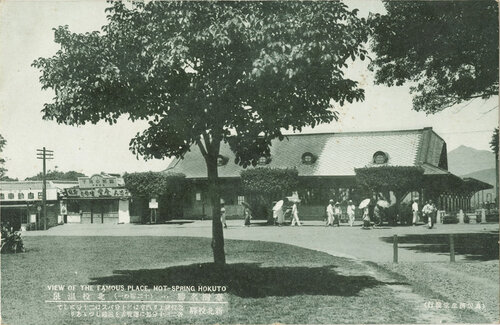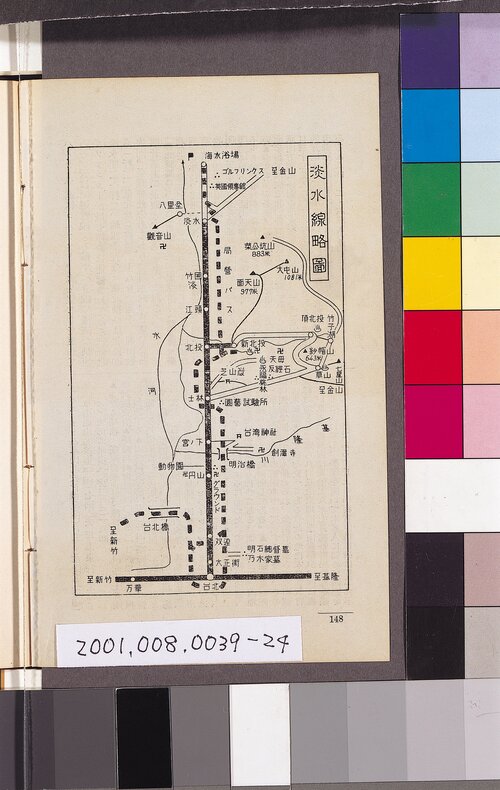The Story Of The Summer Evening Festival ---Starting From The Railroad
Text / 片倉佳史
Editor/ 郭慧
Picture provided / 國立台灣大學圖書館、國立台灣歷史博物館、漢文臺灣日日新報[漢珍]、北投溫泉博物館
The Summer Evening Festival And The Tamsui Line
The story about the birth of the Beitou Summer Evening Festival could date back to a railroad. The railroad, connecting Taipei and Tamshui, opened on August 25, 1901. It was the first railroad branch line in Taiwan, even earlier than the opening of the entire Western Trunk line.
Since its opening in 1901, the Tamsui line had gradually developed to include the New Beitou branch line. The Danshui line extends 23 kilometers from Taipei downstream to the Danshui River, with stations at Taisheng Street, Shuanglian, Yuanshan, Gongxia, Shilin, Gillian, Beitou, Jiangtou, and Zhuwei. The current Taipei Metro Tamsui line is based on this foundation, with the "Taisheng Street Station" and "Gongxia Station" abolished, and the "Jiangtou Station" renamed "Guandu Station."
The Presence Of The Summer Evening Train
However, the relationship between the Tamsui line and the Summer Evening Festival began in the summer following the opening of the Tamsui line. In 1902, when the first Beitou Summer Evening Festival was held, participants took the Tamsui line's “Summer Evening Train“ from Taipei to the summer resort, Beitou.
Although there is not enough information about the Summer Evening Train to recapture the past scene, there must have been many tourists who came to Beitou by taking the Summer Evening Train at that time. Tourists enjoyed bathing at a hot spring, or strolling around the hot spring street in their Japanese kimono robes. It was a very bustling place with people coming and going.
In subsequent years, concerts were also held in Beitou Park, and lanterns could be seen hanging everywhere. People enjoyed the hot springs, wandered through the booths, and watched movies at the open-air cinema and so on. Everyone enjoyed their time in Beitau in their own way. It is said that some of these visitors included senior officials from the Government-General of Taiwan.

(Picture provided:北投溫泉博物館)
Swift Gas Turbine Locomotive
Let's go back to the railroad. In 1915, the Railway Department introduced the “gas turbine locomotive" into Taiwan.Unlike the old steam locomotive-powered passenger carriages, it was equipped with driver's seats at both ends and could run with a single carriage. As a result, the efficiency of the trains was improved and they were able to run around the city swiftly. The Tamsui line was the first railway line to use the gas turbine locomotive at that time. Since then, the Summer Evening Train equipped with the gas turbine locomotive, has hit the road. As mentioned earlier, the history of the Summer Evening Train can be traced as far back as before the introduction of the gas turbine locomotive, but it was officially designated as a tourist-only train after the introduction of the gas turbine locomotive.

(Picture provided:國立臺灣大學圖書館藏)
The Branch Line Connecting To Hot Spring Street
In the following year after the introduction of the gas turbine locomotive, the New Beitou branch line, which connects Beitou to the entrance of Hot Spring Street, was also officially opened. It provided a more convenient option for people who had to trek from Beitou Station to the hot spring area.
The total length of the New Beitou branch line is only 1.2 kilometers long with a travel time of about 2 minutes. Beitou Hot Springs, situated in the suburbs of Taipei at that time, had long been famous. The New Beitou Station, located at the entrance to Hot Spring Street, was no doubt very crowded. The New Beitou branch line was mainly used to carry tourists. During the Japanese rule, the railroad served the purpose of transporting goods, and most of the trains on the tracks were carrying goods. In contrast, the New Beitou branch line can be considered one of the few exceptions as a tourist train.
What's more, the biggest highlight of the New Beitou branch line was its convenience.
Thanks to the direct interchange between the New Beitou Station and Taipei, it not only saved the trouble of transferring trains, but also had a high frequency. According to the timetable in 1935, half of the trains from Taipei headed to Danshui and the other half to New Beitou at 30-minute intervals. In addition, the shuttle train that ran between Beitou and New Beitou departed every 30 minutes, allowing passengers to transfer to the Tamsui line from Taipei at Beitou Station without waiting. If we add in the shuttle trains, there would be one train to New Beitou every 30 minutes, running frequently on the railway according to the regular schedule. This type of regular train headway was rare in Taiwan and Japan during the Japanese rule period and it was only found on the New Beitou branch line in Taiwan.
As mentioned above, gas turbine locomotives were so swift that it only took 27 minutes to travel from Taipei to New Beitou. Surprisingly, it also takes 27 minutes to get to New Beitou by Taipei MRT today. However, if we add in the time for the MRT transfer, it is even faster to ride the train to New Beitou during the Japanese rule period than it is today. It is evident how fast and convenient the gas turbine locomotives were back then.

(Picture provided:國立臺灣大學圖書館藏)
Gas Turbine Locomotives Free From Heavy Fumes
It is worth mentioning that all the trains running on the New Beitou branch line at that time were equipped with gasoline engines. It must be pointed out that the popularity of gas turbine locomotives in Japan began in the 1920s after they were introduced from abroad. This means that the gas turbine locomotives running on the New Beitou branch line back then were introduced quite early in the history of Japanese railways.
In fact, the New Beitou Station was the only terminal station in Taiwan with bay platforms at that time. The concave platform that enclosed the incoming trains looked like the teeth of a wooden comb, and the head end of the platform was directly connected to the station building. Such a track configuration must be made without running freight trains. This is because if passenger or freight trains are pulled by a steam locomotive in one direction into the station, it is necessary to use a turntable to turn the front of the train. However, if the vehicle is a gas turbine locomotive with driver's seats at the front and rear, this effort can be saved. The layout of the platform shows that the future introduction of gas turbine locomotives was already decided at the early stage of construction, and the New Beitou branch line was built to carry tourists primarily. It is really admirable how far-sighted people were at that time.
After entering the Showa era, the New Beitou branch line, which was originally designed to carry tourists, began to serve commuters to work and school, as well as worshipers to the Taiwan Grand Shrine, due to the development of the surrounding residential areas. Nevertheless, among the passengers on the branch line trains, most of them are traveling to Beitou Hot Springs for spa and recuperation. The biggest advantage of gas turbine locomotives is that they would not be bothered by heavy fumes like before. At that time, both men and women, young and old, had more or less been exposed to the "baptism" of smoke from steam locomotives. In comparison, the gas turbine locomotives were more comfortable to ride and were well accepted by passengers.

(Picture provided:國立臺灣大學圖書館藏)
Shuttling Rickshaws in Hot Spring Street
Besides "gas turbine locomotive," "rickshaw" is also a key word belonging to the New Beitou station.
Hot Spring Street in Beitou expands along the periphery of Beitou Park. In addition to the hot spring inns scattered all over the city, Beitou Hot Springs covers a large area, starting from the Geothermal Valley (called "Hell Valley" during the Japanese rule period) to the Upper Beitou and even to the Top Beitou in the mountains. This also means that tourists, after leaving the station, would need appropriate transportation when moving to the hotels or hot spring baths, and rickshaws satisfy their needs.
In those days, many rickshaw drivers always lined up in front of the New Beitou Station. Because of the high frequency of trains, crowds of people kept coming and going in front of the station all day long. The Beitau Hot Spring Museum, which was formerly a public bathhouse during the Japanese rule period, also offered a rickshaw hailing stop near the entrance. There was even a service for hiring a rickshaw by calling to a hot spring hotel or maintenance office.
In fact, before the opening of the New Beitou branch line, it was common to take a rickshaw from Beitou Station to Hot Spring Street. In addition to carrying passengers to Hot Spring Street, rickshaws were also often used for transportation to nearby areas. During events such as the Summer Evening Festival, it was the rickshaws that brought the whole area to life.
Unfortunately, since the war gradually heated up after entering the Showa era, the Summer Evening Festival had to be brought to an end. The gas turbine locomotives and rickshaws have also become scenes that exist only in historical memory. Even now, I would still look at the existing historical sites in Beitou Hot Springs and think about how they used to look like in those days.

(Picture provided:北投溫泉博物館)

(Picture provided:國立臺灣歷史博物館收藏)
![(Picture provided:漢文臺灣日日新報[漢珍])](https://hotspringmuseum.labspace.com.tw/storage/manager/浸北投/VOL.1重返納涼祭/1-2故事從鐵路開始說起/1-2-7.jpg)
(Picture provided:漢文臺灣日日新報[漢珍])
